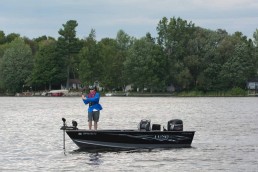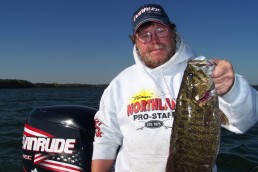Catch More Fish by Making Better Casts
SHARE THIS POST
In his book, Darwin’s Bass, Paul Quinnett states that approximately 88 muscles, plus a lot of brain waves, are required for the human body to execute the throwing motion needed to propel a bait with a fishing rod. Truth be told, I hadn’t really appreciated the physical intricacies of casting until I read his book 10 years ago.
Casting skills deserve attention though for more than just the marvels of human kinetics aside. The reasoning is simple: those who master it catch more fish than those who neglect to hone their lure-launching skills.
Casting methods
There are several different types of casts. Two methods sharing similar mechanics are the overhead and the sidearm casts. These begin with the rod loading from the backswing’s momentum and the lure’s weight. Next, the forward momentum of the follow-through, along with the energy of the unloading rod, propels the bait forward. Within this basic sequence minor elements can be modified for better efficiency, accuracy and distance.
For example, using a quick flick of the wrist to snap the rod tip back and forward with minimal swing is a fast, efficient way to fling light baits, like jigs, with little energy. At the other end of the spectrum, a catapult-like action involving rod swing with no wrist snap is the best way to cast heavy pike and muskie baits. Rod power and action combined with lure mass impacts how fast and aggressive you can cast.
Two other popular casts are the underhand methods of flipping and pitching. These are used to present a lure to a nearby target with precision, like when plunking baits into an opening in weeds when looking for largemouths. Casting outfits are most commonly used for these underhand moves, but spinning combos can also be used to toss light jigs.
Flipping involves casting a preselected amount of line, say, 12 feet. The reel remains engaged (i.e., not in free-spool). The rod is raised with one hand, while the other strips line from between the reel and the first guide. This action shortens the line dangling from the rod tip and causes the bait to swing back toward the angler. Using a pendulum motion, the bait is then swung forward, the rod tip lowered and the stripped line returned to complete the cast.
Pitching follows a similar motion, but with the reel in free-spool to allow for a longer cast. The free hand doesn’t strip line but holds the lure. To execute this cast the rod is raised from a downward pointing position and the bait is released so it swings forward. Then, spool released by lifting the thumb so it feeds line to the flying lure. As bait nears the water the spool is feathered and rod tip lowered to reduce splash.
General principles
Casting shouldn’t be strenuous. There are exceptions, of course, such as heaving a heavy muskie bait or pitching a large bass jig all day. If casting becomes a workout, it likely means your mechanics need correcting. Excess upper body rotation, over-swinging, improper weight transfer, poor timing and overstraining, are common casting errors that can be remedied by focusing on proper form and letting the rod do the work. Like any swinging motion, accuracy increases by following through so the rod’s final position is pointing at the target.
But your equipment plays an important role as well.
Tools of the trade
Quality gear will improve casting efficiency and accuracy. Premium equipment is always a treat to fish with, but today’s midrange equipment touts impressive performance as well. A balanced rod and reel combo will transfer energy the most efficiently and make anyone a better caster. As a general rule, you should be able to balance the rod on a finger placed just above the end of the reel spool.
Balance also refers to matching the rod to the weight of the bait. Most medium-power spinning rods will easily toss a 1/4-ounce jig. Tie on a 1/32-ounce model, however, and the rod won’t load properly and inaccuracy will follow. A rod’s label will detail the weight range it’s designed to handle.
Rods are also engineered for a specific range of line diameters, or strengths. As line passes through a rod’s guides it creates friction, impacting casting distance. Going heavier than recommended will reduce casting distance and require more force to propel a lure. The good news though is that ultra-thin braid or superline provide little friction, making it easy to fling a bait a considerable distance without compromising on line strength.
Ensuring reels are properly tuned, sufficiently lubricated and fully spooled, are other ways to maximize casting efficiency and range.
Are you enjoying this post?
You can be among the first to get the latest info on where to go, what to use and how to use it!
Efficiency and accuracy
Practice makes everyone a better caster, and pre-season training can begin in the backyard or at a local park. Set up some buckets, coffee cans or and other objects to refine your short-distance accuracy and mechanics.
Time on the water is also important. A benefit of angling during early spring is that after catching panfish and catfish for a few weeks, I’ve taken hundreds of casts. And when walleye and pike season opens I’m in peak fishing form and any gear issues have been resolved. Another consideration is taking a video of yourself casting to critique your form. Odds are you’ll see some areas to improve. For inspiration, compare your mechanics to those of the fishing pros on television.
Make the first cast count
A lesson taught to me by two-time Canadian Bass Classic Champion, “Big Jim” McLaughlin, is the importance of a well executed first cast. On a few occasions I’ve seen him stop and yank back a pitch that wasn’t perfect. Whether a wind gust, last-minute observation about the cover, or being slightly off target, McLaughlin will abort and redo a cast instead of presenting a mediocre one to a spot that has the potential to cough up a fish. In short, the first cast to a new area better be your best. Coming in with a poor first cast has the potential of scaring off fish in the vicinity before you’ve delivered a presentation worthy of a bite.
Entry awareness
A common casting error is allowing a lure to land with too much force and not appreciating how in-tune fish are with their environment. I’m sure occasionally a bird of prey loses its grip and sends a free meal falling from the sky and into the lake with a massive splash, but generally, most surface activity is subtle. Try the following to keep entry splashes to a minimum and deliver a natural-looking offering.
Minimize the height of the cast and use a sidearm toss to keep the trajectory low. Don’t throw a lure any harder than is needed to reach the target. Excess energy equates to excess splash. As a lure nears the target, slow it by feathering the line with your palm as it leaves a spinning reel or with your thumb on the spool of a casting reel.
Using a sidearm cast to skip a bait across the water on a low trajectory is another skill to master. The splash sequence is like anti-lock brakes, quickly slowing the lure with a series of pauses instead of one significant stop. This results in an extremely subtle entry. Moreover, this maneuver mimics a baitfish jumping across the surface, which will get the attention of nearby predators. Skipping can also be used to fling baits beneath overhanging cover where bass and other fish hide, like a willow tree or a dock. With that said, a loud lure splash is occasionally a good thing when fish are aggressive. For example, when your partner hooks a smallmouth that comes to the boat with other bass in pursuit, try forcefully casting a tube jig no farther than 10 feet from the boat. This shock-splash technique will get the supercharged smallmouth’s attention and help you hook-up as well. And, loud entries can also get the attention of apex predators, like muskies and pike.
Pacing and planning
Timing is another skill to master; it’s best to fight the urge to immediately bomb out a bait once a target gets within range. Instead be patient, position the boat, and then throw. A properly executed cast is always better than a rushed one.
In a similar vein, plan sequences to maximize water coverage, anticipate the length of time needed for each retrieve, and pace yourself so you can be in the best position to toss a bait to the prime spots. Similar to how a pro billiard player plans out a series of shots in a row before selecting which ball they hit first, you’re casting sequence should be just as strategic, otherwise you’ll miss opportunities. When with a partner, communicate about your casting sequence and which specific targets you’ll each hit.
How far to throw?
Although it can be fun to try and fling baits into the next postal code, it’s rarely necessary and sometimes will hurt your catch-rates. Long casts are best for covering water, like when searching for pike or smallmouths on mid-depth flats with a spinnerbait or swimbait. Distance is also advantageous in shallow, clear water, as getting an offering away from a boat reduces the chances of spooking fish. Keep in mind that casting with the wind helps fling a bait farther than normal.
Short casts are best reserved to quickly and precisely dissect areas, such as when picking apart the edges and the openings of a weed bed. And short to moderate casts are recommended when fish are concentrated because it’s better to catch the fish closest to you first and then target the ones that are farther away. Doing the opposite can spook ones in between you and the hooked fish as the battle unfolds. This is more pronounced in moderate to shallow water than in deeper areas.
Being strategic about how you throw lures is important. Considering how, when and where you cast is one of the easiest ways to increase the number of fish you catch. After all, every presentation starts with a cast, so take aim and give it your best.
Wind tips: Casting into gales is a challenge. Use spinning outfits whenever possible, as casting reels are prone to backlashes when a gust stalls a bait in flight. Also, use short casts to conserve energy, keep the trajectory low, and opt for aerodynamic baits, like jigs, over the bulky ones, like spinnerbaits.
Line lovin’: Applying line conditioner to fluorocarbon and monofilament will increase casting distance, keep line supple, reduce tangles and prolong its life. Douse the reel spool and the rod guides at the end of each fishing outing for best results.
MWO
SHARE THIS POST
Did you enjoy this post?
You can be among the first to get the latest info on where to go, what to use and how to use it!
Tim Allard
Tim Allard is a full-time outdoor journalist and author and photographer of the multi-award-winning book, Ice Fishing––The Ultimate Guide. Follow him on Instagram @timallardtips.



